Leet o Warld Heritage Steids in the Arab states
This is a leet o Warld Heritage Steids in the Arab states,[1] in Wastren Asie an North Africae, occupyin an area stretchin frae the Atlantic Ocean in the wast tae the Arabian Sea in the east, an frae the Mediterranean Sea.
Leet[eedit | eedit soorce]
The leet ablo contains an eemage o the steid or pairt o the steid; the name as inscrievit bi UNESCO; the location; the nominatin state pairty; the criteria met bi the steid, includin gin it is a cultural, naitural or mixed; the area in hectares an acres, excludin ony buffer zones, wi a value o zero implying that nae data is furthset bi UNESCO; the year the steid wis inscrievit; an a descrievin o the steid.
† In danger
| Steid | Eemage | Location | Criteria | Area ha (acre) |
Year | Descrievin |
|---|---|---|---|---|---|---|
| Beni Hammad Fort | 
|
M'sila Province, 35°48′50″N 04°47′36″E / 35.81389°N 4.79333°E |
Cultural: (iii) |
150 (370) | 1980 | In a moontainous steid o extraordinary beauty, the ruins o the first caipital o the Hammadid emirs, foondit in 1007 an demolished in 1152, provide an authentic picture o a fortified Muslim ceety. The mosque, thats prayer room haes 13 aisles wi aicht bays, is ane o the mucklest in Algerie.
. Beni Hammad Fort is near the toun o Maadid (aka Maadhid), aboot 225 kilometres (140 mi) sootheast o Algiers..[2] |
| Djémila | 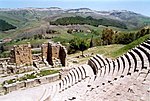
|
Sétif Province, 36°19′14″N 5°44′12″E / 36.32056°N 5.73667°E |
Cultural: (iii)(iv) |
31 (77) | 1982 | Djémila (umwhile kent as Cuicul) wis a Roman toun in a moontainous steid, comprisin a forum, temples, basilicas, triumphal airches an releegious biggins an ither structures, ilka adaptit tae a location 900 m (3,000 ft) abuin sea level.[3] |
| Kasbah o Algiers | 
|
Algiers Province, 36°47′00″N 3°03′37″E / 36.78333°N 3.06028°E |
Cultural: (ii)(v) |
50 (120) | 1982 | The Kasbah o Algiers is a unique Islamic ceety on the Mediterranean coast. It contains remains o a citadel, medieval mosques an Ottoman palaces.[4] |
| M'zab Valley | 
|
Ghardaïa Province, 32°29′00″N 3°41′00″E / 32.48333°N 3.68333°E |
Cultural: (ii)(iii)(v) |
4,000 (9,900) | 1982 | The intact, tradeetional human habitat wis biggit aroond five ksour o the M'zab Valley in the 10t yeirhunner bi the Ibadites.[5] |
| Tassili n'Ajjer | 
|
Illizi an Tamanrasset Provinces, 25°30′00″N 9°00′00″E / 25.50000°N 9.00000°E |
Mixed: (i)(iii)(vii)(viii) |
7,200,000 (18,000,000) | 1982 | A vast plateau on the edge o the Sahara, Tassili n'Ajjer contains mair nor 15,000 cave engravings that record climatic chynges, ainimal migrations, an the evolution o human life, datin frae 6,000 BCE til the first yeirhunners CE. It is noted for its erodit sandstone landforms an aw.[6] |
| Timgad | 
|
Batna Province, 35°27′00″N 6°38′00″E / 35.45000°N 6.63333°E |
Cultural: (ii)(iii)(iv) |
91 (220) | 1982 | Established bi Emperor Trajan in 100 CE as a militar colony, Timgad features cardo an decumanus streets, consteetutin a teepical ensaumple o Roman toun-plannin.[7] |
| Tipasa | 
|
Tipaza Province, 36°32′00″N 2°22′00″E / 36.53333°N 2.36667°E |
Cultural: (iii)(iv) |
52 (130) | 1982 | Previously a Carthaginian tredin centre, Tipasa wis conquered bi the Romans an convertit intae a militar base. The steid bears witness tae paleochristian an Byzantine influences an aw.[8] |
| Dilmun Burial Moonds | 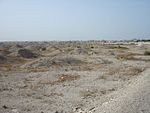
|
Northren Govrenorate, 26°8′59″N 50°30′46″E / 26.14972°N 50.51278°E |
Cultural: (iii)(iv) |
168.45 (416.2) | 2019 | Locatit in the wastren pairt o Bahrain Island, Dilmun Burial Moonds date back tae the Dilmun, the Umm al-Nar culture. Thay war biggit atween 2050 an 1750 BCE include 21 aircheologeecal steids wi mair nor 11 K burial moonds an 17 ryal moonds biggit as 2-storeyed buirial touers.[9] |
| Qal'at al-Bahrain – Auncient Harbour an Caipital o Dilmun | 
|
Northren Govrenorate, 26°13′59″N 50°31′38″E / 26.23306°N 50.52722°E |
Cultural: (ii)(iii)(iv) |
32 (79) | 2005 | Qal'at al-Bahrain wis the caipital o the Dilmun ceevilisation, bearin witness tae continuous human occupation frae circa 2300 BC tae the present. A Portuguese fort staunds on the tap o the steid.[10] |
| Pearlin, Testimony o an Island Economy | 
|
26°14′28″N 50°36′49″E / 26.24111°N 50.61361°E |
Cultural: (iii) |
35,087 (86,700) | 2012 | Conseestin o biggins in Muharraq, oyster beds, a segment o the coast an a fortress, the steid testifies tae the pearlin tradeetion that dominatit the Arabian Gulf frae the 2nt yeirhunner til the early 20t yeirhunner, whan the introduction o cultured pearls frae Japan resultit in the crash o pearlin economy in Bahrain.[11] |
| Abu Mena | 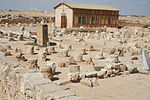
|
Alexandria Govrenorate, 30°51′00″N 29°40′00″E / 30.85000°N 29.66667°E |
Cultural: (iv) |
183 (450) | 1979 | The ruins o the umwhile Christian halt ceety contain a kirk, a baptistery, basilicas, public biggins, streets, monasteries, hooses, an workshops, an wis biggit ower the tomb o Menas o Alexandria.[12] |
| Auncient Thebes wi its Necropolis | 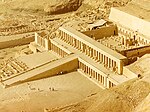
|
Luxor Govrenorate, 25°44′00″N 32°36′00″E / 25.73333°N 32.60000°E |
Cultural: (i)(iii)(vi) |
7,390 (18,300) | 1979 | The umwhile caipital o Egyp an the ceety o Amun, Thebes contains temples an palaces at Karnak an Luxor, as weel as the necropolises at the Valley o the Keengs an the Valley o the Queens, bearin witness tae the hicht o the Egyptian ceevilisation.[13] |
| Historic Cairo | 
|
Cairo Govrenorate, 30°03′00″N 31°15′40″E / 30.05000°N 31.26111°E |
Cultural: (i)(v)(vi) |
524 (1,290) | 1979 | Ane o the warld's auldest Islamic ceeties an in the middle o urban Cairo, the steid dates frae the 10t yeirhunner an reached its gowden age in the 14t yeirhunner. It contains mosques, madrasah, hammams an foontains.[14] |
| Memphis an its Necropolis – the Pyramid Fields frae Giza tae Dahshur | 
|
Giza Govrenorate, 30°03′00″N 31°15′40″E / 30.05000°N 31.26111°E |
Cultural: (i)(v)(vi) |
16,358.52 (40,422.8) | 1979 | The caipital o the Auld Kinrick o Egyp haes some extraordinary funerary moniments, includin rock tombs, ornate mastabas, temples an pyramids. In ancient times, the steid wis conseedert ane o the Seiven Wunners o the Warld.[15] |
| Nubian Monuments frae Abu Simbel tae Philae | 
|
Aswan Govrenorate, 22°20′11″N 31°37′34″E / 22.33639°N 31.62611°E |
Cultural: (i)(iii)(vi) |
374 (920) | 1979 | Locatit alang the Nile, the steid contains monuments sic as the Temple o Ramesses II at Abu Simbel an the Sanctuary o Isis at Philae, saufed frae bein submerged bi Loch Nasser as a result o the construction o the Aswan Dam.[16] |
| Saunt Catherine Area | 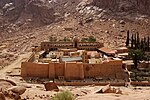
|
Sooth Sinai Govrenorate, 28°33′22″N 33°58′32″E / 28.55611°N 33.97556°E |
Cultural: (i)(iii)(iv)(vi) |
60,100 (149,000) | 2002 | The orthodox monastery o Saunt Catherine is amang the auldest Christian monasteries still in function. Datin frae the 6t yeirhunner, it is poseetioned near Mount Horeb whaur, accordin tae the Auld Testament, Moses received the Tablets o the Law. The region is saucrit for Christians, Muslims an Jews.[17] |
| Wadi Al-Hitan (Whale Valley) | 
|
Faiyum Govrenorate, 29°20′00″N 30°11′00″E / 29.33333°N 30.18333°E |
Natural: (viii) |
20,015 (49,460) | 2005 | Locatit in wastren Egyp, Wadi Al-Hitan contains fossil remains o the nou extinct Archaeoceti, mappin the evolution o the whales frae a laund-based tae an aquatic mammal.[18] |
| The Ahwar o Soothren Iraq: Refuge o Biodiversity an the Relict Laundscape o the Mesopotamian Ceeties | 
|
31°33′44″N 47°39′28″E / 31.56222°N 47.65778°E |
Mixed: (iii)(v)(ix)(x) |
211,544 (522,740) | 2016 | Locatit in soothren Iraq, the steid contains three ceeties o Sumerian oreegin, namely Uruk, Ur an Eridu, in addition tae fower wetland area in the Iraqi Marshlands.[19] |
| Babylon | 
|
Babil Govrenorate, 32°32′31.09″N 44°25′15″E / 32.5419694°N 44.42083°E |
Cultural: (iii)(vi) |
1,054.3 (2,605) | 2019 | [20] |
| Erbil Citadel | 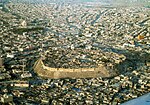
|
Arbil Govrenorate, 36°11′28″N 44°00′33″E / 36.19111°N 44.00917°E |
Cultural: (iv) |
16 (40) | 2014 | Situatit on the tap o a tell in Iraqi an owerleukin the ceety o Erbil, the Erbil Citadel consteetutes a teepical ensaumple o Ottoman-era urban-planning. In addeetion tae its 19t century fortifeecations, the steid contains remains datin back tae the Assirian period an aw.[21] |
| Ashur (Qal'at Sherqat) | 
|
Salah ad Din Govrenorate, 35°27′32″N 43°15′35″E / 35.45889°N 43.25972°E |
Cultural: (iii)(iv) |
70 (170) | 2003 | Locatit on the Tigris an datin frae the 3rd millennium BCE, Ashur wis the first caipital o the Assirian Empire an the releegious centre o the Assirians. Follaein its destruction bi the Babylonians, the ceety wis briefly revived durin the Parthian period.[22] |
| Hatra | 
|
Ninawa Govrenorate, 35°35′17″N 42°43′06″E / 35.58806°N 42.71833°E |
Cultural: (ii)(iii)(iv)(vi) |
324 (800) | 1985 | The fortified Parthian ceety o Hatra withstuid repeatit attacks bi the Roman Empire in the 2nt yeirhunner. Its airchitectur reflects baith Hellenistic an Roman influences.[23] |
| Samarra Aircheological Ceety | 
|
Salah ad Din Govrenorate, 34°20′28″N 43°49′25″E / 34.34111°N 43.82361°E |
Cultural: (ii)(iii)(iv) |
15,058 (37,210) | 2007 | Locatit on the Tigris, the Islamic ceety of Samarra wis the caipital o the Abbasid Caliphate. It contains twa o the lairgest mosques an seiveral o the mucklest palaces in the Islamic warld, in addeetion tae bein amang the finest ensaumple o Abbasid-era toun-plannin.[24] |
| Bapteesm Steid "Bethany Beyond the Jordan" (Al-Maghtas) | 
|
31°50′14″N 35°33′10″E / 31.83722°N 35.55278°E |
Cultural: (iii)(vi) |
294 (730) | 2015 | Situatit on the Jordan River, Al-Maghtas is conseedert the location o the Bapteesm o Jesus bi John the Baptist. A Christian pilgrimage steid, it contains remains o Roman an Byzantine kirks, chapels, a monastery, caves an pools.[25] |
| Petra | 
|
Ma'an Govrenorate, 30°19′50″N 35°26′36″E / 30.33056°N 35.44333°E |
Cultural: (i)(iii)(iv) |
— | 1985 | The Nabataean ceety o Petra wis a major tredin hub atween Arabie, Egyp an Sirie-Phoenicie, famed for its rock-cut airchitectur as weel as its minin an watter engineerin seestems.[26] |
| Quseir Amra | 
|
Zarqa Govrenorate, 31°48′7″N 36°35′9″E / 31.80194°N 36.58583°E |
Cultural: (i)(iii)(iv) |
— | 1985 | The desert castle o Quseir Amra wis biggit in the early 8t yeirhunner, an haed served baith as a fortress an an Umayyad ryal pailace. The steid awso notit for its extensive frescoes, consteetitim an important an unique ensaumple o early Islamic airt.[27] |
| Um er-Rasas (Kastrom Mefa'a) | 
|
Madaba Govrenorate, 31°30′6″N 35°55′14″E / 31.50167°N 35.92056°E |
Cultural: (i)(iv)(vi) |
24 (59) | 2005 | Established as a Roman militar camp, Um er-Rasas grew intae a settlement bi the 5t yeirhunner, inhabitit successively bi Christian an Islamic communities. The maistly unexcavatit steid contains ruins o Roman fortifeecations, kirks wi weel-preserved mosaic fluirs an twa stylite touers.[28] |
| Wadi Rum Fendit Area | 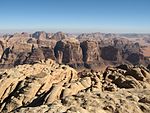
|
29°38′23″N 35°26′02″E / 29.63972°N 35.43389°E |
Mixed: (iii)(v)(vii) |
74,180 (183,300) | 2005 | Situatit in soothren Jordan, Wadi Rum features a great variety o desert laundforms includin saundstone valleys, naitural arches, gorges, cliffs, laundslides an caverns. The steid awso contains extensive rock airt, inscriptions an archaeological remains, bearin witness tae mair nor 12,000 years of continuous human habitation.[29] |
| Anjar | 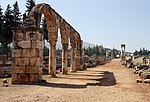
|
Beqaa Govrenorate, 33°43′33″N 35°55′47″E / 33.72583°N 35.92972°E |
Cultural: (iii)(iv) |
— | 1984 | Established in the early 8t yeirhunner, the ceety o Anjar wis quick abandoned follaein the faw o the Umayyad Caliphate, leavin ahint ruins o waws, touers, pailaces, mosques an baths, consteetutin an ensaumple o Umayyad period toun-planning.[30] |
| Baalbek | 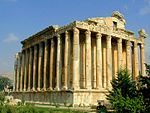
|
Baalbek-Hermel Govrenorate, 34°00′25″N 36°12′18″E / 34.00694°N 36.20500°E |
Cultural: (i)(iv) |
— | 1984 | Previously kent as Heliopolis, the Phoenician ceety o Baalbek hosts some o the mucklest an best preserved Roman temples, includin the Temples o Jupiter, Venus an Bacchus.[31] |
| Byblos | 
|
Moont Lebanon Govrenorate, 34°07′09″N 35°38′51″E / 34.11917°N 35.64750°E |
Cultural: (iii)(iv)(vi) |
— | 1984 | Continuously inhabitit syne the Neolithic Era, Byblos wis ane o the auldest ceeties o Phoenician oreegin. It haes syne witness Persie, Roman, Crusader an Ottoman occupation, ilka exertin influence upon its airchitectur. Byblos awso played a signifeecant role in the diffusion o the Phoenician alphabet.[32] |
| Ouadi Qadisha (the Haly Valley) an the Forest o the Cedars o God (Horsh Arz el-Rab) | 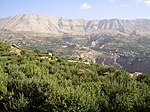
|
North Lebanon Govrenorate, 34°14′36″N 36°02′56″E / 34.24333°N 36.04889°E |
Cultural: (iii)(iv) |
— | 1998 | The Qadisha Valley haes gien shelter for Christian communities syne the beginnings o Christianity, hostin a lairge nummer o monasteries an hermitages. The Forest o the Cedars o God is amang the last locations whaur Cedrus libani still graws, historically ane o the maist prized construction materials.[33] |
| Tyre | 
|
Sooth Lebanon Govrenorate, 33°16′19″N 35°11′40″E / 33.27194°N 35.19444°E |
Cultural: (iii)(vi) |
154 (380) | 1984 | The ancient Phoenician ceety o Tyre wis ane o the foremaist maritime pouers in the eastren Mediterranean an reportitly whaur purple dye wis discovert. Extant airchaeological remains mainly date back tae Roman times, includin baths, an arena, a colonnaded road, a triumphal airch, an aqueduct an a hippodrome.[34] |
| Archaeological Steid o Cyrene | 
|
Jabal al Akhdar, 32°49′30″N 21°51′30″E / 32.82500°N 21.85833°E |
Cultural: (ii)(iii)(vi) |
— | 1982 | The formerly Greek colony o Cyrene wis Romanized an transformed intae a caipitsl, til it wis destroyed bi the 365 Crete earthquake. The thoosand-year-auld ruins hae remained renowned syne the 18t yeirhunner.[35] |
| Archaeological Steid o Leptis Magna | 
|
Khoms, 32°38′18″N 14°17′35″E / 32.63833°N 14.29306°E |
Cultural: (i)(ii)(iii) |
— | 1982 | The Roman ceety o Leptis Magna wis made muckler bi Emperor Septimius Severus, that wis born thare. Public monuments, a harbour, a marketplace, storehooses, shops, an homes wis amang the reasons for its induction intae the leet.[36] |
| Airchaeological Steid o Sabratha | 
|
Zawiya Destrict, 32°48′19″N 12°29′06″E / 32.80528°N 12.48500°E |
Cultural: (iii) |
— | 1982 | Foondit as a Phoenician tredin post, Sabratha wis briefly ruled bi Masinissa o Numidie afore its Romanization an reconstruction in the 2nt an 3rd yeirhunners.[37] |
| Auld Toun o Ghadamès | 
|
Nalut Destrict, 30°08′00″N 9°30′00″E / 30.13333°N 9.50000°E |
Cultural: (v) |
— | 1986 | Locatit in an oasis, Ghadames is amang the auldest o pre-Saharan ceeties an represents a tradeetional domestic airchitectur wi vertical deevision o functions.[38] |
| Rock-airt steids o Tadrart Acacus | 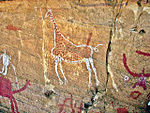
|
Fezzan, 24°50′00″N 10°20′00″E / 24.83333°N 10.33333°E |
Cultural: (iii) |
— | 1985 | The massif o Tadrart Acacus contains thoosands o cave pentins in different styles, datin frae 12,000 BCE tae 100 CE, reflectin chynges o flora an fauna in the region as weel as different lifestyles o successive populations in the Sahara.[39] |
| Ancient Ksour o Ouadane, Chinguetti, Tichitt an Oualata | 
|
Ouadane, Chinguetti, Tichitt, an Oualata, 20°55′44″N 11°37′25″W / 20.92889°N 11.62361°W |
Cultural: (iii)(iv)(v) |
— | 1996 | Thir fower settlements wis foondit in the 11t an 12t yeirhunners, oreeginally meant tae serve caravan tred routes across the Sahara. Thay gradually evolved intae Islamic cultural centres, bearin witness tae the nomadic lifestyle o the populations o wastren Sahara.[40] |
| Banc d'Arguin Naitional Pairk | 
|
Nouadhibou an Azefal, 20°14′05″N 16°06′32″W / 20.23472°N 16.10889°W |
Natural: (ix)(x) |
1,200,000 (3,000,000) | 1989 | The pairk conseests o saund dunes, coastal swamps, smaw islands, an shallow bodies o watter; aw borderin the coast o the Atlantic Ocean. Birds are eften fand tae migrate in the area, accompanied bi various species o sea turtles an dolphins, thats presence fishermen eften uise tae attract fish.[41] |
| Airchaeological steid o Volubilis | 
|
Fès-Meknès, 34°04′26″N 5°33′25″W / 34.07389°N 5.55694°W |
Cultural: (ii)(iii)(iv)(vi) |
42 (100) | 1997 | The important Roman ootpost of Volubilis wis foondit in the 3rd yeirhunner BCE as the caipital o Mauretanie, later becomin the caipital o the Idrisid dynasty. It contained mony biggins, the remains o that hae survived extensively tae this day.[42] |
| Historic Ceety o Meknes | 
|
Fès-Meknès, 33°53′00″N 5°33′30″W / 33.88333°N 5.55833°W |
Cultural: (iv) |
— | 1996 | The umwhile caipital o the Alaouite dynasty wis foondit in the 11t yeirhunner bi the Almoravids an turnt intae a ceety wi Spaingie-Moorish influence durin the 17t an 18t yeirhunners.[43] |
| Ksar o Ait-Ben-Haddou | 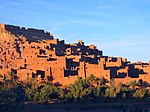
|
Drâa-Tafilalet, 31°02′50″N 7°07′44″W / 31.04722°N 7.12889°W |
Cultural: (iv)(v) |
3 (7.4) | 1987 | The Ksar o Ait-Ben-Haddou is an ensaumple o a tradeetional pre-Saharan habitat in soothren Morocco, surroondit bi heich waws an reinforced wi corner touers.[44] |
| Medina o Essaouira (formerly Mogador) | 
|
Marrakesh-Safi, 31°31′00″N 9°46′10″W / 31.51667°N 9.76944°W |
Cultural: (ii)(iv) |
30 (74) | 2001 | Biggit durin the late 18t yeirhunners, the fortified seaport o Essaouira haes a mix o North African an European airchitectur, an wis a major tredin hub atween the Sahara an Europe.[45] |
| Medina of Fez | 
|
Fez, 34°03′40″N 4°58′40″W / 34.06111°N 4.97778°W |
Cultural: (ii)(v) |
280 (690) | 1981 | Fez wis foondit in the 9t yeirhunner an reached its apogee as the caipital o the Marinid dynasty in the 13t an 14t yeirhunners, frae that its urban fabric an major monuments date. It awso hosts the warld's varsity, the Varsity o Al Quaraouiyine.[46] |
| Medina o Marrakesh | 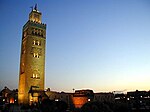
|
Marrakesh-Safi, 31°37′53″N 7°59′12″W / 31.63139°N 7.98667°W |
Cultural: (i)(ii)(iv)(v) |
1,107 (2,740) | 1985 | Marrakesh wis foondit in the 1070s an remained a political, economic, an cultural centre for a lang time. Monuments frae that period include the Koutoubia Mosque, the kasbah, an the battlements. The ceety awso hauds newer features, sicklik pailaces an madrasas.[47] |
| Medina o Tétouan (formerly kkent as Titawin) | 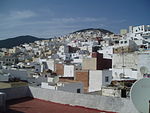
|
Tanger-Tetouan-Al Hoceima, 35°34′15″N 5°22′00″W / 35.57083°N 5.36667°W |
Cultural: (ii)(iv)(v) |
7 (17) | 1997 | Morocco's maist complete medina at Tétouan served as the main pynt o contact atween Morocco an Andalusie durin the 8t yeirhunner. The toun wis rebiggit bi Andalusian refugees follaein the Reconquista, the influence o that is evident in its airt an airchitectur.[48] |
| Rabat, Modren Caipital an Historic Ceety: a Shared Heritage | 
|
Rabat, 34°01′27″N 6°49′22″W / 34.02417°N 6.82278°W |
Cultural: (ii)(iv) |
349 (860) | 2012 | Rebiggit unner the direction o the French frae 1912 til the 1930s, Rabat blends historic an modren features, sic as botanical gardens, the Hassan Mosque, an the remnants o Moorish an Andalusian settlements frae the 17t yeirhunner.[49] |
| Portuguese Ceety of Mazagan (El Jadida) | 
|
Casablanca-Settat, 33°15′24″N 8°30′07″W / 33.25667°N 8.50194°W |
Cultural: (ii)(iv) |
8 (20) | 2004 | The Portuguese fortifeecation o Mazagan, akin tae early Renaissance militar design frae the early 16t yeirhunner, wis taen ower bi Morocco in 1769. Survivin biggins include the cistern an a Gothic kirk.[50] |
| Aflaj Irrigation Seestems o Oman | 
|
Dakhiliyah, Sharqiyah an Batinah Regions, 22°59′56″N 57°32′10″E / 22.99889°N 57.53611°E |
Cultural: (v) |
1,456 (3,600) | 2006 | The five Aflaj seestem inscrievit represents an irrigation method datin back tae at least 500 CE. Sic seestem effectively distribute watter throu gravity, as it flaws tae support agricultural an domestic uise.[51] |
| Auncient Ceety o Qalhat | 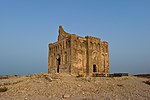
|
Ash Sharqiyah Sooth Govrenorate, 22°42′N 59°22′E / 22.700°N 59.367°E |
Cultural: (ii)(iii) |
75.82 (187.4) | 2018 | [52] |
| Archaeological Steids o Bat, Al-Khutm an Al-Ayn | 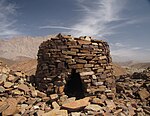
|
Ad Dhahirah Region, 23°16′11″N 56°44′42″E / 23.26972°N 56.74500°E |
Cultural: (iii)(iv) |
— | 1988 | Located in the interior o the Sultanate, Bat, al-Khutm an al-Ayn are amang the best preserved ensembles o settlements an necropolises frae the 3rd yeirthoosan BCE in Eastren Arabie an the warld. The necropolis o Bat, in pairteecular, reflects the buirial practices o the Early Bronze Age in Oman.[53] |
| Bahla Fort | 
|
Ad Dakhiliyah Region, 22°57′51″N 57°18′04″E / 22.96417°N 57.30111°E |
Cultural: (iv) |
— | 1987 | The fort is pairt o Bahla, an oasis settlement an formerly the caipital o the Nabhani dynasty, that dominatit Oman an prospered in the Arabian Peninsula durin the Late Middle Ages.[54] |
| Laund of Frankincense | 
|
Dhofar Govrenorate, 18°15′12″N 53°38′51″E / 18.25333°N 53.64750°E |
Cultural: (iii)(iv) |
850 (2,100) | 2000 | The ancient ports o Khor Rori an Al-Baleed, the caravan oasis o Shisr an Wadi Dawkah in soothren Arabie wis crucial in the production an distribution o frankincense, ane o the maist sacht-efter items o luxury in Antiquity.[55] |
| Auld Ceety o Jerusalem an its Walls | 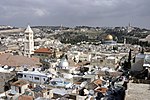
|
East Jerusalem 31°46′00″N 35°13′00″E / 31.76667°N 35.21667°E |
Cultural: (ii)(iii)(vi) |
— | 1981 | A haly ceety for three o the warld's major releegions, Jerusalem contains mair nor 200 historic monuments, includin the Dome o the Rock, the Wailin Waw an the Kirk o the Haly Sepulchre.[56] |
| Birthplace o Jesus: Kirk o the Nativity an the Pilgrimage Route, Bethlehem | 
|
Bethlehem Govrenorate, 31°42′16″N 35°12′27″E / 31.70444°N 35.20750°E |
Cultural: (ii)(iii) |
3 (7.4) | 2012 | The steid is tradeetionally identifeed as the birthplace o Jesus. The kirk, biggit in the 4t yeirhunner an reconstructit in the 6t yeirhunner, hauds heich releegious signifeecance tae baith Christians an Muslims.[57][58] |
| Palestine: Laund o Olives an Vines — Cultural Laundscape o Soothren Jerusalem, Battir | 
|
Bethlehem Govrenorate, 31°43′11″N 35°07′50″E / 31.71972°N 35.13056°E |
Cultural: (iv)(v) |
349 (860) | 2014 | The hill lanudscape o Battir features stane terraces for mercat gairden, grapevine an olive production, supportit bi a tradeetional irrigation seesrem.[59] |
| Hebron/Al-Khalil Old Town | 
|
Hebron Govrenorate, 31°31′30″N 35°06′30″E / 31.52500°N 35.10833°E |
Cultural: (ii)(iv)(vi) |
20.6 (51) | 2017 | The centre o interest o the toun wis the steid o Al mosque -Ibrahim / the tomb o the Patriarchs that biggins are in a compoond biggit in the 1st yeirhunner CE tae fend the tombs o the patriarch Abraham / Ibrahim an his faimily.[60] |
| Al Zubarah Airchaeological Steid | 
|
Al Shamal, 25°58′41″N 51°01′47″E / 25.97806°N 51.02972°E |
Cultural: (iii)(iv)(v) |
416 (1,030) | 2013 | The coastal toun o Al Zubarah wis a major pearlin an treddin centre in the Persian Gulf in the late 18t an early 19t yeirhunners, afore its destruction in 1811 an eventual abandonment in the early 20t yeirhunner. The remains o its pailaces, mosques, harbour, fortifeecations an ither structures are preserved bi the saund blawn frae the desert.[61] |
| Al-Hasa | 
|
Hofuf, Al-Ahsa Govrenorate 25°25′46″N 49°37′19″E / 25.42944°N 49.62194°E |
Cultural: (iii)(iv)(v) |
8,544 (21,110) | 2018 | [62] |
| Al-Hijr Aircheologeecal Steid (Madâin Sâlih) | 
|
Al Madinah Province, 26°47′01″N 37°57′18″E / 26.78361°N 37.95500°E |
Cultural: (ii)(iii) |
1,621 (4,010) | 2008 | Formerly kent as Hegra, the steid o Al-Hijr consteetutes the mucklest settlement o the Nabataean Kinrick efter Petra. It contains a series o weel-preserved rock-cut tombs an moniments datin back tae the 1st yeirhunner BCE.[63] |
| At-Turaif Destrict in ad-Dir'iyah | 
|
Riyadh Province, 24°44′03″N 46°34′21″E / 24.73417°N 46.57250°E |
Cultural: (ii)(iii) |
29 (72) | 2008 | Foondit in the 15t yeirhunner, the Turaif Destrict of Dir'iyah wis the first caipital o the Saudi dynasty. Dir'iyah witnessed the grawth o its poleetical an religious significance, as weel as the spreid o Wahhabism in the 18t an the early 19t yeirhunners.[64] |
| Historic Jeddah, the Gate tae Makkah | 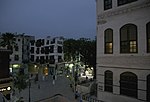
|
Makkah Region, 21°29′02″N 39°11′15″E / 21.48389°N 39.18750°E |
Cultural: (ii)(iv)(vi) |
18 (44) | 2014 | Locatit on the coast o the Reid Sea, Jeddah grawed intae a major commercial centre in the 7t yeirhunner, an haes lang serrt as the principal gateway for pilgrims tae Mecca.[65] |
| Rock Airt in the Ha'il Region | Ha'il Region, 28°00′38″N 40°54′47″E / 28.01056°N 40.91306°E |
Cultural: (i)(iii) |
2,044 (5,050) | 2015 | The steids o Jabel Umm Sinman an Jabal al-Manjor an Raat contain a lairge nummer o petroglyphs an inscriptions, coverin 10,000 years o human history.[66] | |
| Airchaeological Steids o the Island o Meroe | 
|
River Nile State, 16°56′00″N 33°43′00″E / 16.93333°N 33.71667°E |
Cultural: (ii)(iii)(iv)(v) |
2,357 (5,820) | 2011 | Meroe wis the centre o the Kinrick o Kush, a major force active frae the 8t yeirhunner BCE til the 4t yeirhunner CE. It is hame tae pyramids, temples, an domestic biggins, amang ither vestiges.[67] |
| Gebel Barkal an the Steids o the Napatan Region | 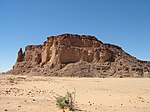
|
Northren State, 18°32′00″N 31°49′00″E / 18.53333°N 31.81667°E |
Cultural: (i)(ii)(iii)(iv)(vi) |
183 (450) | 2003 | The airchaeological steids o Gebel Barkal, Kurru, Nuri, Sanam an Zuma in the Nile Valley testify tae the Napatan an Meroitic ceevilisations. Thay host a series o pyramids, tombs, temples, pailaces, buirial moonds an funerary chambers.[68] |
| Sanganeb Marine Naitional Pairk an Dungonab Bay – Mukkawar Island Marine Naitional Pairk | 19°44′10″N 37°26′35″E / 19.73611°N 37.44306°E |
Natural: (vii)(ix)(x) |
199,524 (493,030) | 2016 | Situatit in the central Reid Sea, Sanganeb, Dungonab Bay an Mukkawar Island featur a diverse seestem o coral reefs, mangroves, seagrass beds, beaches an islets, an host populations o seabirds, marine mammals, fish, sharks, turtles, manta rays an dugongs.[69] | |
| Auncient Ceety o Aleppo | 
|
Aleppo Govrenorate, 36°14′00″N 37°10′00″E / 36.23333°N 37.16667°E |
Cultural: (iii)(iv) |
350 (860) | 1986 | Situatit at the crossroads o seiveral tred routes, Aleppo haes been successively ruled, amang ithers, bi the Romans, Ayyubids, Mameluks an Ottomans, ilka leavin signifeecant influence in its airchitectural fabric, resultin in a diverse ceetyscape. Major structur include the Citadel, the Great Mosque an the Madrasa Halawiye.[70] |
| Auncient Ceety o Bosra | 
|
Daraa Govrenorate, 32°31′05″N 36°28′54″E / 32.51806°N 36.48167°E |
Cultural: (i)(iii)(vi) |
— | 1980 | Formerly a Nabataean dounset, Bosra wis conquered bi the Romans in the 2nt yeirhunner CE an made caipital of Arabia. It came unner Islamic rule in the 7t yeirhunner. Remains o the ancient ceety include a theatre, a basilica, a cathedral, a mosque an a madrasa, amang others.[71] |
| Auncient Ceety o Damascus | 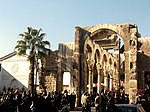
|
Damascus Govrenorate, 33°30′41″N 36°18′23″E / 33.51139°N 36.30639°E |
Cultural: (i)(ii)(iii)(iv)(vi) |
86 (210) | 1979 | Established the 3rd yeirthoosan BCE, Damascus is considered tae be ane o the auldest continuously inhabited ceeties in the warld. As the caipital o the Umayyads, it haes been of significant influence tae the Arab warld. The Great Mosque is amang the mucklest in the warld an the auldest sites of continuous prayer syne the beginnins of Islam.[72] |
| Auncient Veelages o Northren Sirie | 
|
36°20′03″N 36°50′39″E / 36.33417°N 36.84417°E |
Cultural: (iii)(iv)(v) |
12,290 (30,400) | 2011 | The steid comprises some 40 touns, datin frae the 1st til 7t yeirhunners an abandoned in the 8t til 10t yeirhunners. Thay gie an insicht intae rural life in Late Antiquity an during the Byzantine period.[73] |
| Crac des Chevaliers an Qal'at Salah El-Din | 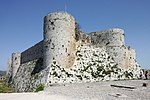
|
Homs an Latakia Govrenorate, 34°46′54″N 36°15′47″E / 34.78167°N 36.26306°E |
Cultural: (ii)(iv) |
9 (22) | 2006 | The Crac des Chevaliers an the Qal'at Salah El-Din are regairdit as twa o the maist prominent ensaumples o castles durin the Crusader period, demonstratin an evolution o fortifeecations an exchynge o influences in defensive technology.[74] |
| Steid o Palmyra | 
|
Homs Govrenorate, 34°33′15″N 38°16′00″E / 34.55417°N 38.26667°E |
Cultural: (i)(ii)(iv) |
0.36 (0.89) | 1980 | Palmyra came unner Roman rule in the 1st yeirhunner CE, an grawed tae become ane o the maist important cultural centres o the ancient warld. Its extensive ruins includes remains o the Great Colonnade, the Temple o Bel, the Camp o Diocletian an the Roman Theatre.[75] |
| Airchaeological Steid of Carthage | 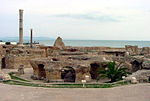
|
Tunis Govrenorate, 36°51′10″N 10°19′24″E / 36.85278°N 10.32333°E |
Cultural: (ii)(iii)(vi) |
616 (1,520) | 1979 | Foondit in the 9t yeirhunners BCE, Carthage developit intae a tredin empire spannin the Mediterranean. The ceety wis destroyed in 146 BCE in the Punic Wars at the haunds o the Romans, but wis later reestablished.[76] |
| Dougga / Thugga | 
|
Béja Governorate, 36°25′25″N 9°13′13″E / 36.42361°N 9.22028°E |
Cultural: (ii)(iii) |
70 (170) | 1997 | The steid features the ruins o Dougga, a umwhile caipital o a Libie–Punic state, that flourished unner the Romans an the Byzantines, but went intae decline in the Islamic period.[77] |
| Amphitheatre o El Jem | 
|
Mahdia Govrenorate, 35°17′47″N 10°42′25″E / 35.29639°N 10.70694°E |
Cultural: (iv)(vi) |
1.37 (3.4) | 1979 | Biggit durin the 3rd yeirhunner, the Amphitheatre o El Jem is North Africae's lairgest amphitheatre, an the mucklest ane biggit ootside o Italy, wi a capaceety of 35,000 spectators, regairdit as amang the maist accomplished ensaumples o Roman airchitectur o its kynd.[78] |
| Ichkeul Naitional Pairk | 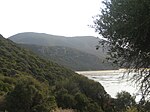
|
Bizerte Govrenorate, 37°09′49″N 9°40′29″E / 37.16361°N 9.67472°E |
Natural: (x) |
12,600 (31,000) | 1980 | Ichkeul Lake an the surroondin wetlaunds is a destination for hunders o thoosands o migratin birds, includin ducks, geese, storks an pink flamingos. It wis ance pairt o a chain that extendit athort North Africae.[79] |
| Kairouan | 
|
Kairouan Govrenorate, 35°40′54″N 10°06′14″E / 35.68167°N 10.10389°E |
Cultural: (i)(ii)(iii)(v)(vi) |
68 (170) | 1988 | Foondit in 670, Kairouan wis the umwhile caipital of Ifriqiya an flourished in the 9t yeirhunner. Its heritage includes the Mosque of Uqba an the Mosque o the Three Gates.[80] |
| Medina o Sousse | 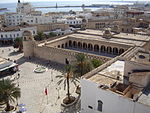
|
Sousse Governorate, 35°49′40″N 10°38′19″E / 35.82778°N 10.63861°E |
Cultural: (iii)(iv)(v) |
32 (79) | 1988 | A prime ensaumple o a toun frae the early Islamic period, Sousse wis an important commercial an military port durin the 9t yeirhunner.[81] |
| Medina o Tunis | 
|
Tunis Govrenorate, 36°49′00″N 10°10′00″E / 36.81667°N 10.16667°E |
Cultural: (ii)(iii)(v) |
296 (730) | 1979 | The Medina o Tunis contains some 700 moniments, includin pailaces, mosques, mausoleums, madrasah an foontains, testifyin tae Tunis' gowden age frae the 12t til the 16t yeirhunner.[82] |
| Punic Toun o Kerkuane an its Necropolis | 
|
Nabeul Govrenorate, 36°56′47″N 11°05′57″E / 36.94639°N 11.09917°E |
Cultural: (iii) |
— | 1985 | Abandoned in 250 BCE durin the First Punic War an niver rebiggit, Kerkuane is the anelie survivin ensaumple o a Phoenicio–Punic settlement.[83] |
| Cultural Steids o Al Ain (Hafit, Hili, Bidaa Bint Saud an Oases Airts) | 
|
Abu Dhabi, 24°04′04″N 55°48′23″E / 24.06778°N 55.80639°E |
Cultural: (iii)(iv)(v) |
4,945 (12,220) | 2011 | Situatit in a desert region, Al Ain haes been occupied syne the Neolithic period, hostin stane tombs frae the 3rd yeirthoosan BCE, wells, adobe constructions an ane o the auldest ensaumples o the aflaj irrigation seestem at Bidaa Bint Saud.[84] |
| Historic Toun o Zabid | 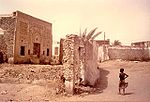
|
Al Hudaydah Govrenorate, 14°11′53″N 43°19′48″E / 14.19806°N 43.33000°E |
Cultural: (iii) |
— | 1993 | Zabid wis the caipital o Yemen frae the 13t til the 15t yeirhunner. Its Islamic varsity greatly contreibutit tae the spreid o Islamic wittins.[85] |
| Auld Ceety o Sana'a | 
|
Sana'a Govrenorate, 15°21′20″N 44°12′29″E / 15.35556°N 44.20806°E |
Cultural: (iv)(v)(vi) |
— | 1986 | Situatit in a moontain valley, Sana'a haes been continuously inhabitit for mair nor 2,500 years. It became a centre for the spread o Islam in the 7t an 8t yeirhunners. The city is hame tae the unique rammed-earth touer-houses, in addition tae 103 mosques an 14 hammams biggit afore the 11t yeirhunner.[86] |
| Auld Walled Ceety o Shibam | 
|
Hadhramaut Govrenorate, 15°55′37″N 48°37′36″E / 15.92694°N 48.62667°E |
Cultural: (iii)(iv)(v) |
— | 1982 | The 16t-century wawed ceety o Shibam is amang the auldest an best ensaumples o vertical urban planning, wi its distinct mud brick touer hooses garnerin it the nickname "the Manhattan o the desert".[87] |
| Socotra Archipelago | 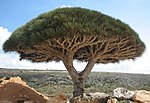
|
Socotra Govrenorate, 12°30′00″N 53°50′00″E / 12.50000°N 53.83333°E |
Natural: (x) |
410,460 (1,014,300) | 2008 | Awtho pairt o the African laundmass, the Socotra Archipelago is admeenistered frae Yemen. It is kent for its great biodiversity an distinct flora an fauna, wi a lairge nummer o endemic species fand naewhaur else on earth. It awso supports a broad range o avian an marine life.[88] |
References[eedit | eedit soorce]
- ↑ World Heritage Centre - World Heritage List
- ↑ "Al Qal'a of Beni Hammad". UNESCO. Retrieved 17 August 2011.
- ↑ "Djémila". UNESCO. Retrieved 17 August 2011.
- ↑ "Kasbah of Algiers". UNESCO. Retrieved 17 August 2011.
- ↑ "M'zab Valley". UNESCO. Retrieved 17 August 2011.
- ↑ "Tassili n'Ajjer". UNESCO. Retrieved 17 August 2011.
- ↑ "Timgad". UNESCO. Retrieved 17 August 2011.
- ↑ "Tipaza". UNESCO. Retrieved 17 August 2011.
- ↑ "Dilmun Burial Mounds". UNESCO. Retrieved 9 Julie 2019.
- ↑ "Qal'at al-Bahrain – Ancient Harbour and Capital of Dilmun". UNESCO. Retrieved 17 August 2011.
- ↑ "Pearling, Testimony of an Island Economy". UNESCO. Retrieved 1 Julie 2012.
- ↑ "Abu Mena". UNESCO. Retrieved 17 August 2011.
- ↑ "Ancient Thebes with its Necropolis". UNESCO. Retrieved 17 August 2011.
- ↑ "Historic Cairo". UNESCO. Retrieved 17 August 2011.
- ↑ "Memphis and its Necropolis – the Pyramid Fields from Giza to Dahshur". UNESCO. Retrieved 24 December 2016.
- ↑ "Nubian Monuments from Abu Simbel to Philae". UNESCO. Retrieved 17 August 2011.
- ↑ "Saint Catherine Area". UNESCO. Retrieved 17 August 2011.
- ↑ "Wadi Al-Hitan (Whale Valley)". UNESCO. Retrieved 17 August 2011.
- ↑ "The Ahwar of Southern Iraq: Refuge of Biodiversity and the Relict Landscape of the Mesopotamian Cities". UNESCO. Retrieved 6 August 2016.
- ↑ "Babylon". UNESCO. Retrieved 9 Julie 2019.
- ↑ "Erbil Citadel". UNESCO. Retrieved 2 Januar 2015.
- ↑ "Ashur (Qal'at Sherqat)". UNESCO. Retrieved 17 August 2011.
- ↑ "Hatra". UNESCO. Retrieved 17 August 2011.
- ↑ "Samarra Archaeological City". UNESCO. Retrieved 17 August 2011.
- ↑ "Baptism Site "Bethany Beyond the Jordan" (Al-Maghtas)". UNESCO. Retrieved 6 October 2015.
- ↑ "Petra". UNESCO. Retrieved 17 August 2011.
- ↑ "Qasr Amra". UNESCO. Retrieved 17 August 2011.
- ↑ "Um er-Rasas (Kastrom Mefa'a)". UNESCO. Retrieved 17 August 2011.
- ↑ "Wadi Rum Protected Area". UNESCO. Retrieved 17 August 2011.
- ↑ "Anjar". UNESCO. Retrieved 17 August 2011.
- ↑ "Baalbek". UNESCO. Retrieved 17 August 2011.
- ↑ "Byblos". UNESCO. Retrieved 17 August 2011.
- ↑ "Ouadi Qadisha (the Holy Valley) and the Forest of the Cedars of God (Horsh Arz el-Rab)". UNESCO. Retrieved 17 August 2011.
- ↑ "Tyre". UNESCO. Retrieved 17 August 2011.
- ↑ "Archaeological Site of Cyrene". UNESCO. Retrieved 17 August 2011.
- ↑ "Archaeological Site of Leptis Magna". UNESCO. Retrieved 17 August 2011.
- ↑ "Archaeological Site of Sabratha". UNESCO. Retrieved 17 August 2011.
- ↑ "Old Town of Ghadamès". UNESCO. Retrieved 17 August 2011.
- ↑ "Rock-Art Sites of Tadrart Acacus". UNESCO. Retrieved 17 August 2011.
- ↑ "Ancient Ksour of Ouadane, Chinguetti, Tichitt and Oualata". UNESCO. Retrieved 17 August 2011.
- ↑ "Banc d'Arguin National Park". UNESCO. Retrieved 17 August 2011.
- ↑ "Archaeological Site of Volubilis". UNESCO. Retrieved 17 August 2011.
- ↑ "Historic City of Meknes". UNESCO. Retrieved 17 August 2011.
- ↑ "Ksar of Ait-Ben-Haddou". UNESCO. Retrieved 17 August 2011.
- ↑ "Medina of Essaouira (formerly Mogador)". UNESCO. Retrieved 17 August 2011.
- ↑ "Medina of Fez". UNESCO. Retrieved 17 August 2011.
- ↑ "Medina of Marrakesh". UNESCO. Retrieved 17 August 2011.
- ↑ "Medina of Tétouan (formerly known as Titawin)". UNESCO. Retrieved 17 August 2011.
- ↑ "Rabat, Modern Capital and Historic City: a Shared Heritage". UNESCO. Retrieved 6 Februar 2016.
- ↑ "Portuguese City of Mazagan (El Jadida)". UNESCO. Retrieved 17 August 2011.
- ↑ "Aflaj Irrigation Systems of Oman". UNESCO. Retrieved 17 August 2011.
- ↑ "Ancient City of Qalhat". UNESCO. Retrieved 29 Juin 2018.
- ↑ "Archaeological Sites of Bat, Al-Khutm and Al-Ayn". UNESCO. Retrieved 17 August 2011.
- ↑ "Bahla Fort". UNESCO. Retrieved 17 August 2011.
- ↑ "Land of Frankincense". UNESCO. Retrieved 17 August 2011.
- ↑ "Old City of Jerusalem and its Walls". UNESCO. Retrieved 17 August 2011.
- ↑ "Birthplace of Jesus: Church of the Nativity and the Pilgrimage Route, Bethlehem". UNESCO. Retrieved 12 Mey 2016.
- ↑ "The site of the Birthplace of Jesus in Bethlehem (Palestine) removed from the List of World Heritage in Danger". UNESCO. Retrieved 7 Julie 2019.
- ↑ "Palestine: Land of Olives and Vines – Cultural Landscape of Southern Jerusalem, Battir". UNESCO. Retrieved 12 Mey 2016.
- ↑ "Hebron/Al-Khalil Old Town - UNESCO World Heritage Centre". Unesco. Retrieved 7 Julie 2017.
- ↑ "Al Zubarah Archaeological Site". UNESCO. Retrieved 3 Mey 2015.
- ↑ "Al-Ahsa Oasis, an Evolving Cultural Landscape". UNESCO. Retrieved 29 Juin 2018.
- ↑ "Al-Hijr Archaeological Site (Madâin Sâlih)". UNESCO. Retrieved 17 August 2011.
- ↑ "At-Turaif District in ad-Dir'iyah". UNESCO. Retrieved 17 August 2011.
- ↑ "Historic Jeddah, the Gate to Makkah". UNESCO. Retrieved 12 October 2015.
- ↑ "Rock Art in the Hail Region of Saudi Arabia". UNESCO. Retrieved 12 October 2015.
- ↑ "Archaeological Sites of the Island of Meroe". UNESCO. Retrieved 17 August 2011.
- ↑ "Gebel Barkal and the Sites of the Napatan Region". UNESCO. Retrieved 17 August 2011.
- ↑ "Sanganeb Marine National Park and Dungonab Bay – Mukkawar Island Marine National Park". UNESCO. Retrieved 6 August 2016.
- ↑ "Ancient City of Aleppo". UNESCO. Retrieved 17 August 2011.
- ↑ "Ancient City of Bosra". UNESCO. Retrieved 17 August 2011.
- ↑ "Ancient City of Damascus". UNESCO. Retrieved 17 August 2011.
- ↑ "Ancient Villages of Northern Syria". UNESCO. Retrieved 17 August 2011.
- ↑ "Crac des Chevaliers and Qal'at Salah El-Din". UNESCO. Retrieved 17 August 2011.
- ↑ "Site of Palmyra". UNESCO. Retrieved 17 August 2011.
- ↑ "Archaeological Site of Carthage". UNESCO. Retrieved 17 August 2011.
- ↑ "Dougga / Thugga". UNESCO. Retrieved 17 August 2011.
- ↑ "Amphitheatre of El Jem". UNESCO. Retrieved 17 August 2011.
- ↑ "Ichkeul National Park". UNESCO. Retrieved 17 August 2011.
- ↑ "Kairouan". UNESCO. Retrieved 17 August 2011.
- ↑ "Medina of Sousse". UNESCO. Retrieved 17 August 2011.
- ↑ "Medina of Tunis". UNESCO. Retrieved 17 August 2011.
- ↑ "Punic Town of Kerkuane and its Necropolis". UNESCO. Retrieved 17 August 2011.
- ↑ "Cultural Sites of Al Ain (Hafit, Hili, Bidaa Bint Saud and Oases Areas)". UNESCO. Retrieved 6 Februar 2016.
- ↑ "Historic Town of Zabid". UNESCO. Retrieved 17 August 2011.
- ↑ "Old City of Sana'a". UNESCO. Retrieved 17 August 2011.
- ↑ "Old Walled City of Shibam". UNESCO. Retrieved 17 August 2011.
- ↑ "Socotra Archipelago". UNESCO. Retrieved 17 August 2011.
Freemit airtins[eedit | eedit soorce]
- UNESCO World Heritage Centre – Offeecial steid
- Leet o UNESCO Warld Heritage Steids – Offeecial steid
- VRheritage.org – documentation o Warld Heritage Steids
- Worldheritage-Forum – Information an Weblog on Warld Heritage Issues
